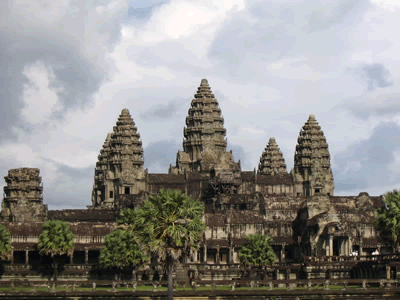
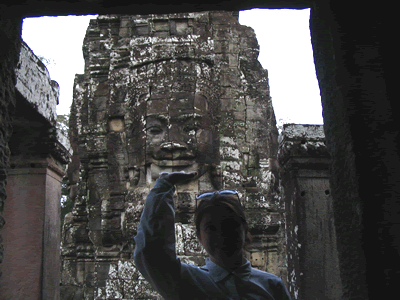
(Angkor Wat on the left; on the right, Heidi holding up King Jayavarman VII ... or Vishnu ... or an aspect of the Buddha ...)


(Angkor Wat on the left; on the right, Heidi holding up King
Jayavarman VII ... or Vishnu ... or an aspect of the Buddha ...)
Angkor Wat is one of a sprawling collection of ancient stone temples in northwest Cambodia. The temples were constructed by various kings of the Khmer people between around 850 AD and 1200 AD. They are a truly fascinating place to visit, both for their architectural details and their cultural insight. Many of the temples have undergone extensive restoration by researchers from many different countries (although primarily France, Japan and India), while some are still in a state of being reclaimed by the jungle. The entire area is a focus for research, restoration, tourism, and study, and has been named a World Heritage Site. We had about three days to travel around the area of these temples, not nearly long enough to explore them all.
The area where Angkor Wat lies is the historical seat of power for the kings of the Khmer people of ancient Cambodia, who at various times controlled large parts of the regions that are modern-day Vietnam, Laos, Cambodia, Thailand and Malaysia. The history of the Angkor Wat temples is basically the history of the rise and fall of these Khmer kings, and the rise and fall (and rise, and fall) of the favored religion of the land.
The first king to start a building program was Indravarman I, in the late 800's. Other kings followed and built new temples at various sites in the general area, dedicated to Hindu gods such as Vishnu and Shiva (when the religion was Hindu), or dedicated to the Buddha (when the religion was Buddhism). The temples formed the military and religious center of the Khmer empire, when it was successful, and included irrigation and reservoirs to support people living in the area. The reservoirs also had religious significance - tower structures of the temples represented Mount Meru, the mythical home of the Hindu gods, and the reservoirs represented lakes that surround Mount Meru.
Two particular kings built some of the largest and most recognizable temples. Suryavarman II had his people build Angkor Wat in the early 1100's, dedicated particularly to Vishnu (this is easily the most well-preserved and famous of the temples, and while not the largest it is quite large and impressive). Later, Jayavarman VII had built the temples Angkor Thom (a whole city, really), Ta Nei, Ta Prohm, Banteay Kdei and others, in the late 1100's to early 1200's. These later temples were Buddhist, however, and quite different in many ways. We saw many examples of temples that had been built by one king as a Hindu or Buddhist temple, that was changed or defaced by a later king's people that had switched back to the other religion - many temples had small alcoves all along the walls where statues of the Buddha had once sat, now empty because they were systematically destroyed during a later Hindu reign.
After the late 1200's, the control of the Khmer people waned, and they did not build any more temples in this area, while the existing ones started to crumble and the jungle grew over them (although some continued to be occupied and kept up by smaller groups). People "discovered" the temples in the 1800's and published stories about them, and this attracted people to start clearing and restoring of many of the structures. Some temples are still "as-is", however; Ta Prohm and Beng Melea are two we visited like this. Today, it is the biggest (well, really, only) tourist attraction in Cambodia.
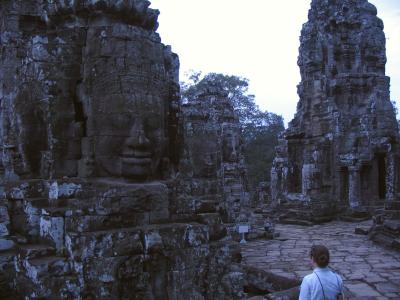
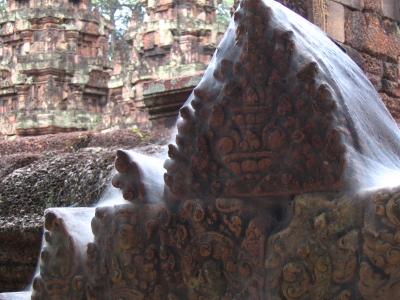
(Four-face towers at Angkor Thom; spider webs on a carved
lintel at Banteay Srei)
Believe it or not, it's not hard to get to the Angkor Wat temples. The temples are just a couple kilometers away from the city of Siem Reap, which is undergoing quite a tourist-hotel-construction boom. You can fly directly to Siem Reap (there are several flights each day); our flight was on Bangkor Airlines, just a 1-hour commuter-plane flight from Bangkok. People from most countries can get a tourist visa right at the airport, you don't have to apply beforehand (you do need to bring a passport photo to give them, also another one for a multi-day pass to the temples). We arranged with our hotel (Angkor Village) to pick us up at the airport. The hotel also arranged the guide and car and driver that we hired to take us to the temples, which is a very helpful thing to have (yes, it IS remarkably hot and humid there).
While you can exchange for Cambodian riels at the airport, in practice there is no need right now - basically everything is transacted in US dollars. I suspect this may eventually change, but for now you can just bring a good supply of small bills to pay for food, cab rides, postcards from the hordes of small children that ask you to "buy my postcards madam!", etc.
There were plenty of visitors to the temples while we were there, but it was not terribly crowded, and for many of the temples only one or two other groups of people would be around when we walked through them. October is the end of their cool rainy season, so it is not the peak time for tourists. You have to buy an access pass to the area, about $20 per person per day; we bought three-day passes.
Here are a couple photos of our hotel, and our guide (Khut) and driver (Savon).

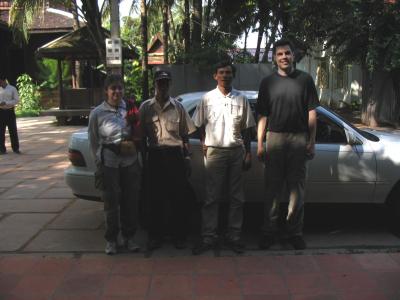
(The central courtyard of the Angkor Village Hotel in Siem
Reap; at right, Heidi, our tour guide Khut, our driver Savon, and Bill, arranged
in order of increasing height)
We had two and a half days for "rubble-gazing" (as a British couple we met put it). There are many temples and they are spread around, and if you have a guide it can take some time to go through some of them and learn about the interesting aspect of it, so we could have spent a couple more days and still not seen everything. So the following list is not of all temples there, just the ones we were able to visit. Please click on the temple name to see photos from that temple.
|
Temple
|
Description
|
| Angkor Wat | Most famous temple, in amazing condition, with bas-relief carvings all around the first level |
| Prasat Kravan | Early Hindu temple, different construction with bricks |
| Banteay Kdei | Late Buddhist temple, with popular four-faced towers |
| Ta Prohm | Very scenic, not restored; trees and vines run riot |
| Ta Kea | Was hit by lightning during construction ("a bad sign") and never finished |
| Angkor Thom | A whole city, with several temples and structures inside it (Bayon, Baphuon, many others) |
| Phnom Bakeng | Most notable lately because it is on a hill overlooking Angkor Wat; people go here to view the sunset |
| Beng Melea | Very very cool - Jungle-covered, and far away from Siem Reap. We were the only ones here for some time. |
| Banteay Srei | The "woman's" temple because its stone carvings are "too intricate to have been made by a man" |
| Banteay Samre | Similar to Angkor Wat, from the same period, but smaller |
| Pre Rup | This was a crematorium for some of the kings |
Of the temples, some of our favorites were Angkor Wat (of course), Ta Prohm (very interesting, and the guides reminded us several times it was where they filmed some parts of the first Tomb Raider movie), Banteay Srei (very interesting stone carvings) and Beng Melea. Beng Melea was particularly fascinating - it was a two-hour drive away from Siem Reap, is unrestored and very interesting with the jungle growing over it. It is only recently accessible, since they cleared out the land mines around it in just the past couple years. Because it is relatively remote from the main areas around Siem Reap, it was much less crowded, and for most of the hour we wandered around we did not see anyone else.
Our camera had an option to create short AVI movies, and I tried to take a couple panning shots of some interesting areas. Click on the links here to download a movie (although they're large, and my bandwidth is not huge, so be gentle ;-)